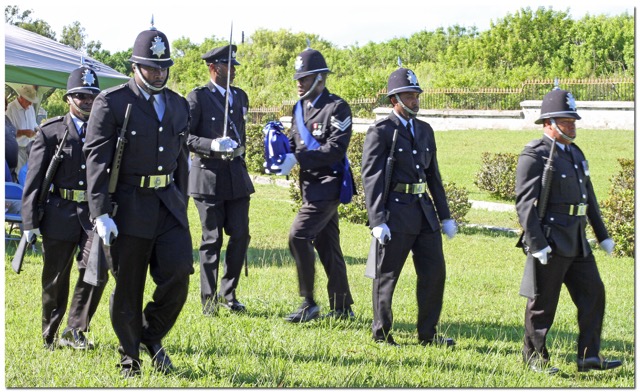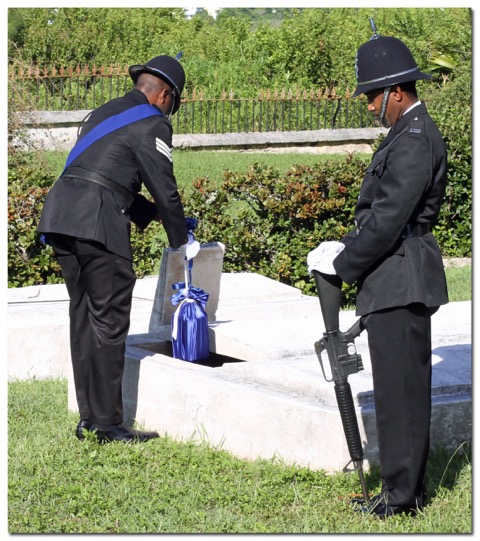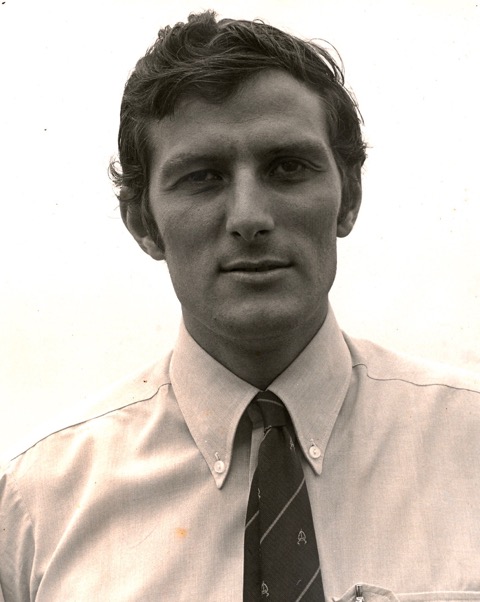Doting Grandfathers!








For more information about the Lavery grandchildren go to our new column on "Grandparents" at



This section features interesting articles written by former colleagues on a wide range of subjects related to the Bermuda Police Service or recounting personal experiences. We are delighted to receive articles from anyone who wishes to put pen to paper, and will assist with editing where necessary.














 Colour Party arrives at Cemetery
Colour Party arrives at Cemetery
















Kindly submitted by retired Superintendent George Rose

When browsing recently through documents in my possession I came across a four page pamphlet described as a ‘Supplement 1989’ inserted inside the 110th Anniversary Issue of the October 1989 Bermuda Police Magazine. On the colourful front cover of the magazine under the words “IMAGES PAST AND PRESENT” could be seen a photographic representation of “our two latest recruits, W.P.C. Shacolbi Smith and P.C. Calon Hollis, with one of our first constables, Thomas J. Powell”. Constable Powell was depicted in full winter uniform with the letters HPC clearly depicted on the forward collar of his tunic along with a trio of medals on his left breast. Three stripes can be seen ringing his lower left sleeve above the wrist. The photo is credited to D/Sgt. Howard Cutts.
The four page Supplement insert carried inside of it *IN MEMORIUM* the obituaries of the following four officers.
Serving Constable George Howard Kirkham (1945 – 1989); Retired Chief Superintendent Oliver Salsbury W. Trott, QPM CPM (1914 – 1989) Please click on the following to read our 'Hall of Fame' article on "Chief Trott" http://expobermuda.com/index.php/hof2/184-olivertrott ; Retired Detective Constable Earl Sinclair Hazel (1915 – 1989) and Retired Police Constable Murdoch Ferguson (1903 – 1989).
In respect of Constable Murdoch Ferguson about whom this article is written, his obituary read as follows:

“Pc Murdoch Ferguson (retired) (1903 – 1989)
Murdoch Ferguson who died on August 28th 1989 in his native Scotland was one of the Bermuda Police’s oldest pensioners. Murdoch was born in Benbecula, Outer Hebrides, one of the remotest parts of the British Isles, and was a farm worker prior to joining the Bermuda Police in 1935. The references he received from his parish priest, headmaster and solicitor testified to his strength of character and obliging nature.
Murdoch’s entire career was spent in Central Division where he worked for many years as the Paget District Constable. He was described as a “firm, straight forward Police Officer with an eye to detail and of quiet disposition. Murdoch Ferguson retired from the Bermuda Police in 1958, and was employed at Bellevue, Paget. He made his home on Bostock Hill. Murdoch served Bermuda faithfully and deepest condolences are extended to his family”. Author: Unknown.
Since my own Celtic bloodline heritage is that from the Scottish Highlands (with a 3 x Great Grandfather born in Ardclach, Nairnshire in 1779), I decided to research Murdoch’s history in an attempt to determine how and why he had entered into the service of the Bermuda Police in 1935. It seemed to me that he was a character worthy of my time and research effort in an attempt to answer these fundamental questions. He originated from ‘one of the remotest parts of the British Isles’ and his upbringing must have been tough and solitary. I was intrigued to learn by what manner of circumstance he had found himself resident on another such isolated island as Bermuda. Who or what was the magnet that drew Murdoch to Bermuda. Who was his Island contact and by what means did he travel here? Clearly, travel to Bermuda in those pre-war days was long and difficult and just didn’t occur by happenstance.
Using the details written in his obituary I commenced a search of the available online Scottish Statutory records which produced an early lead.

So, here was Murdoch aged 8 years and recorded as speaking only Gaelic. He had an older brother Fergus and an older sister May C. Ferguson. We now have a family unit upon which to build. Let’s put some flesh on the bones.
A thorough search in the Statutory Birth Registration records for Scotland revealed that Murdoch was born at the 3rd hour and 11th minute on the 2nd March 1903 in Hacklet, Benbecula, an island in the Outer Hebrides, Inverness-shire, Scotland. His birth registration record his father as Donald Ferguson, Crofter, who was present at birth and made his mark thus – X. His mother is shown as Mary Ferguson, whose maiden name was MacLeod.

Nothing more can yet be found about Murdoch’s early life in the Outer Hebrides but on the 24th December 1934 he migrated to New York on board the S.S. ‘Transylvania’ out of Glasgow, Scotland. We know this from the ‘LIST OR MANIFEST OF ALIEN PASSENGERS FOR THE UNITED STATES’ which records Murdoch’s age as 31 years with an occupation as that of ‘Crofter’. It describes him as being a single man who can read and write English with a place of birth given as Benbecula, Scotland.

Murdoch’s life to this point is best reflected in the written contents of his obituary describing him as a farm worker together with references he received from his parish priest, headmaster and solicitor testifying as to his strength of character and obliging nature. The next Census report – at his age of 18 – and one which would have identified him further is that for 1921, but there is extant ‘the 100 year rule’ which prevents the release of this census until the year 2021.
We know from his obituary that on 14th January 1935 Murdoch, at the age of 32, joined the Bermuda Police Force and later became the Paget Parish (District) Constable. Roger Sherratt reached out to retired Bermuda Police Assistant Commissioner (Crime) Ian Morrison – a fellow Scotsman who knew Murdoch in Bermuda and had served on the job with him. Ian told Roger that Murdoch was married to an [unknown] employee of the big house where they both lived. [Could that big house have been ‘Bellevue’, Paget?]
In 1946 Murdoch is recorded in the Bermuda Blue Book as a 1st Class Constable earning £475 per annum plus a uniform allowance in lieu of quarters of £48 per annum. Source: Roger Sherratt – Blue Book references.
In 1958 Murdoch retired from Bermuda Police and was employed at ‘Bellevue’, Paget, Bermuda - and later at the Belco showrooms on Reid Street, Hamilton. He resided in Bostock Hill, Paget, Bermuda.
Source: Ian Morrison email 16 Sept 2016
Murdoch died on 20th August 1989 in New Kilpatrick, East Dunbartonshire, Scotland [City of Glasgow]. His place of burial has not yet been recovered from either of the two cemeteries at this location since they are only partially recorded to date. His marriage details and any children he may have had are proving difficult to find at present. The date and place of marriage remain unknown at present and, in any event, the marriage may not necessarily have been in Bermuda or to a local female.
AND THEN, out of the blue, along came a nugget of information from Ian Morrison who said, almost as an aside:
“I understand that Murdoch’s brother was an Inspector on the job but before my time. Murdoch has a daughter living on the Island name and whereabouts unknown to me but ……..” Source: Ian Morrison email 16 Sept 2016
So there, for now, lie the results of the investigation into Murdoch’s life. More work is planned in the weeks ahead.
At least we now know from census records that Murdoch had an older brother by the name of Fergus Ferguson.
Could it be this Fergus to whom Ian Morrison is referring when he wrote? – “I understand that Murdoch’s brother was an Inspector on the job but before my time”.
Turning our attention now to Fergus Ferguson, a search in the Statutory Birth Registration records for Scotland revealed that Fergus was born at 12 noon on the 23rd January 1901 at Hacklet, in the District of Benbecula, County of Inverness-shire, Scotland. His birth registration records his father as Donald Ferguson, Crofter, who was present at birth and who made his mark thus – X. His mother is shown as Mary Ferguson nee MacLeod.
The 1911 Census at Hacklet, Grimsay, Benbecula, (District) of Inverness-shire records Fergus Ferguson as aged 10 and being a speaker of the Gaelic and English languages.
On 1st May 1927 at the age of 26, Fergus is next seen in the Bermuda Blue Book as joining the Bermuda Police Force. Some two years later on the 15th September 1929 in the ‘LIST OR MANIFEST OF ALIEN PASSENGERS FOR THE UNITED STATES’ Fergus is recorded as travelling to New York on board the S.S. “Albertic” which had departed Greenock (Tail of the Bank), Scotland. The record gave his age as 28 years and 5 months stating that he was an unmarried Police Constable who could read. He further declared himself to be British and of the Scots race having been born in Benbecula, Scotland. Interestingly, in the source document he gave Bermuda as his last country of residence and there is seen the notation *In transit to Bermuda*. These last two entries tend to confirm that Fergus was a returning resident of Bermuda in 1929 and was en route to the island from Scotland.

In 1946 Fergus is last seen in the Bermuda Blue Book as holding the rank of Inspector and earning £650 per annum plus £96 allowance.
It is now clear that Murdoch had arrived in Bermuda and joined the Bermuda Police with the assistance of his elder brother Fergus. Enquiries are under way to locate and speak with any surviving relatives Murdoch may still have on the island.
Questions arise in relation to Fergus however and research is ongoing to determine the circumstances leading to his first arrival in Bermuda in 1927. Who and what drew him to the island? Did he marry and raise a family here? When did he retire from the Bermuda Police and what happened to him afterwards? When did he pass away and where is he buried? Does an obituary exist for him? Are there any case histories listed for him during his career as a Bermuda police officer? And what of the brothers’ eldest sister Mary C. ? Did she play a role in Fergus’ relocation to Bermuda, or can she be eliminated from the equation?
It is a fact that in earlier centuries the Scots were predominant throughout the colonial world including the Caribbean and in the Isthmus of Panama. But what of their early presence in Bermuda and of their connections back home in Scotland? What were the recruiting policies of the Bermuda Police / Government in the early decades of the 20th Century?
In keeping with Police traditions this is a continuing team effort to gain more information about these two former police colleagues and retirees. I would be grateful to receive information from anyone who can add to the biography of Fergus and Murdoch Ferguson.